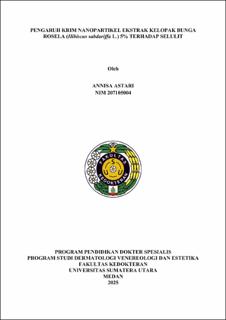Pengaruh Krim Nanopartikel Ekstrak Kelopak Bunga Rosela (Hibiscus sabdariffa L.) 5% terhadap Selulit
The Effect of 5% Nanoparticle Cream of Roselle Flower Petal Extract (Hibiscus sabdariffa L.) on Cellulite

Date
2025Author
Astari, Annisa
Advisor(s)
Putra, Imam Budi
Jusuf, Nelva Karmila
Metadata
Show full item recordAbstract
Background: Cellulite is a topographic change in the skin characterized by a wavy
appearance or a texture resembling orange peel, cottage cheese, or mattress-like
patterns. No standard therapy has been established for the treatment of cellulite. The
objectives of cellulite therapy are to enhance microvascularization, stimulate
lipolysis, improve the structure of dermal and subcutaneous tissues, and prevent
free radical damage. Roselle petals contain various active compounds such as
anthocyanins, ascorbic acid, hibiscus acid, and flavonols, which contribute to the
improvement of cellulite through mechanisms that enhance microcirculation,
provide anti-inflammatory and antioxidant effects, stimulate lipolysis, and support
collagen synthesis.
Objective: To determine the effect of a 5% nanoparticle cream containing roselle
petal extract (Hibiscus sabdariffa L.) on cellulite.
Methods: A Quasi Experimental clinical trial was conducted using a pretest
posttest design involving 30 subjects with cellulite. Diagnosis was established
through anamnesis and clinical examination. Evaluation was performed using the
Photonumeric Cellulite Severity Scale (PCSS), assessed at weeks 0, 2, 4, 6, and 8
following the application of a 5% nanoparticle cream containing roselle petal
extract (Hibiscus sabdariffa L.). Side effects and satisfaction levels were recorded
throughout the study. The Friedman test was used to analyze differences before and
after treatment, with a p-value <0.05 considered statistically significant.
Result: The characteristics of the study subjects showed that the majority were aged
between 26–35 years (46.67%) and most had a family history of cellulite,
predominantly from their mothers (63.3%). There was a statistically significant
reduction in the severity of cellulite (p<0.05) after 8 weeks of cream application.
No side effects were reported, and all subjects expressed satisfaction based on their
level of satisfaction.
Conclusion: The application of a 5% nanoparticle cream containing roselle petal
extract (Hibiscus sabdariffa L.) can improve the appearance of cellulite.
Keywords: Cellulite, Hibiscus sabdariffa L., Photonumeric Cellulite Severity
Scale.
Collections
- Master Theses [212]
